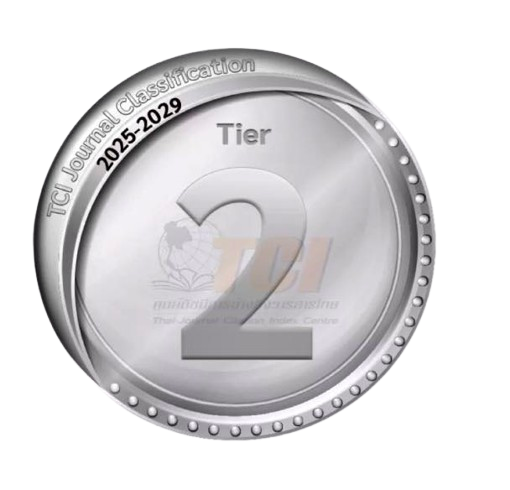การปิดช่องว่างฟันหน้าบนและการบูรณะฟันที่มีขนาดเล็กด้วยเซรามิกวีเนียร์
คำสำคัญ:
ฟันรูปหมุด, ฟันห่าง, เซรามิกวีเนียร์บทคัดย่อ
ผู้ป่วยหญิงไทย อายุ 33 ปี มาพบทันตแพทย์ด้วยอาการสำคัญ คือ ฟันหน้าบนมีขนาดเล็กร่วมกับมีช่องว่างระหว่างฟัน ทำให้รู้สึกฟันไม่สวยและไม่มั่นใจในรอยยิ้ม มีความต้องการบูรณะเพื่อเปลี่ยนรูปร่างและปิดช่องว่างดังกล่าว ผู้ป่วยปฏิเสธโรคประจำตัวและการแพ้ยาใด ๆ จากการตรวจภายในช่องปาก พบฟันรูปหมุดบริเวณฟันตัด ซี่ข้างซี่ 12 และ 22 โดยฟันซี่ 22 สลับตำแหน่งกับฟันซี่ 23 ซึ่งเป็นผลมาจากการจัดฟันเมื่อ 2 ปีที่ผ่านมา และพบมีช่องว่างระหว่างฟันซี่ 11 และ 12 ประมาณ 0.5 มิลลิเมตร ช่องว่างระหว่างฟันซี่ 12 และ 13 ประมาณ 0.5 มิลลิเมตร ช่องว่างระหว่างฟันซี่ 22 และ 23 ประมาณ 1.0 มิลลิเมตร และช่องว่างระหว่างฟันซี่ 22 และ 24 ประมาณ 0.5 มิลลิเมตร เมื่อตรวจและวางแผนการรักษาร่วมกับผู้ป่วย ผู้ป่วยได้เลือกการรักษาด้วยการบูรณะด้วยเซรามิกวีเนียร์ 6 ซี่หน้าบน โดยหลังจากทำการรักษาเสร็จได้พิจารณาทำเครื่องป้องกันการสบกระแทก (soft splint) ให้คนไข้ใส่ร่วมด้วย เนื่องจากมีการบูรณะฟันหลายซี่ การใส่เครื่องป้องกันการสบกระแทกดังกล่าวจะช่วยยืดอายุการใช้งานและความคงทนของวัสดุบูรณะได้ หลังจากนั้นได้มีการติดตามผู้ป่วยเป็นระยะเวลา 1 สัปดาห์ 1 เดือน 3 เดือน และ 6 เดือน พบว่าวัสดุบูรณะอยู่ในสภาพดี ไม่มีการแตกบิ่น ไม่มีการติดสีบริเวณขอบวัสดุ สภาวะปริทันต์อยู่ในสภาพปกติ และ ผู้ป่วยมีความพึงพอใจกับสีและรูปร่างของวัสดุบูรณะ มีความมั่นใจในรอยยิ้มมากขึ้น ช่วยเพิ่มคุณภาพชีวิตให้กับผู้ป่วย
อย่างไรก็ตาม การบูรณะด้วยเซรามิกวีเนียร์ควรมีการเลือกผู้ป่วยอย่างเหมาะสม ควรพิจารณาข้อบ่งชี้และข้อห้ามก่อนการวางแผนการรักษา เพื่อให้การบูรณะฟันประสบความสำเร็จสูงสุด ซึ่งความสำเร็จของการรักษาขึ้นอยู่กับหลายปัจจัย ได้แก่ การมีโครงสร้างของฟันเพียงพอ การออกแบบและการกรอแต่ง การยึดติด การประสานงานกับห้องปฏิบัติการ และการเลือกผู้ป่วยที่เหมาะสม เป็นต้น การพูดคุยทำความเข้าใจถึงความต้องการของผู้ป่วย การมีความรู้และทักษะในการทำงานจึงมีความสำคัญ ที่จะทำให้ทันตแพทย์สามารถสร้างชิ้นงานได้สวยงาม ผู้ป่วยพึงพอใจและลดโอกาสเกิดความล้มเหลวจากการบูรณะฟันได้
คำสำคัญ: ฟันรูปหมุด, ฟันห่าง, เซรามิกวีเนียร์
เอกสารอ้างอิง
Peampring C, Sanohkan S. All-ceramic systems in Esthetic Dentistry: A review. M Dent J 2014;34:82-90.
Peumans M, Munck JD, Fieuws S, Lambrechts P, Vanherle G, Meerbeek BV. A prospective ten-year clinical trial of porcelain veneers. J Adhes Dent 2004;6(1):65-76.
Qualtrough AJ, Piddock V. Dental ceramics: what's new? Dent Update 2002;29(1):25-33.
Lim CC. Case selection for porcelain veneers. Quintessence Int 1995;26:311-5.
Garber DA, Goldstein RE, Feinman RA. Porcelain laminated veneers. Chicago: Quintessence Publishing; 1988.
Freedman GA, McLaughlin GL. Color atlas of porcelain laminate veneers. St. Louis. (MO): Ishiyaku EuroAmerica; 1990.
Sheet CG. Advantages and limitation in the use of porcelain veneer restorations. J Prosthet Dent 1990;64:406-11.
Belser UC, Magne P, Magne M. Ceramic laminate veneers: continuous evolution of indications. J Esthet Dent 1997; 9(4): 197-207.
Roberson TM. Heymann HO. Swift EJ JR. Sturdevant’s Art and Science of Operative Dentistry. 4th ed. St. Louis: Mosby; 2001.
Wall AWG, Steele JG, Wassell RW. Crowns and other extra-coronal restorations: porcelain laminated veneers. Br Dent J 2002;193(2):73-82.
Ferrari M, Patroni S, Balleri P. Measurement of enamel thickness I relation to reduction for etched laminated veneers. Int J Periodont Rest Dent 1992;23:407-13.
Gurel G. The science and art of porcelain laminate veneers. London: Quintessence Publishing. 2003.
Small BW. Preparation of teeth for esthetic restorations. Gen Dent 2001; 49:
Ward DH. Proportional smile design using the recurring esthetic dental (RED) proportion. Dent Clin North Am 2001;45(1):143-154.
Alberton SB, Alberton V, de Carvalho RV. Providing a harmonious smile with laminate veneers for a patient with peg-shaped lateral incisors. J Conserv Dent 2017;20(3):210-13.
Sadowsky SJ. An overview of treatment considerations for esthetic restorations: a review of the literature. J Prosthet Dent 2006;96(6):433-42.
Gresnigt MMM, Sugii MM, Johanns KBFW, van der Made SAM. Comparison of conventional ceramic laminate veneers, partial laminate veneers and direct composite resin restorations in fracture strength after aging. J Mech Behav Biomed Mater 2021;114:104-72.
Monaraks R, Leevairoj C. The Longevity of Ceramic Veneers: Clinical Evaluation of Mechanical, Biologic and Aesthetic Performances of Ceramic Veneers, a 7-year Retrospective Study. J Dent Assoc Thai 2018;68(3):228-301.
El-Mowafy O, El-Aawar N, El-Mowafy N. Porcelain veneers: An update. Dent Med Probl 2018;55(2):207-211.
Summit JB, Robbins JW, Hilton TJ, Schwartz RS, editor. Fundamental of operative dentistry: A contemporary Approach. 3rd ed. Illinois: Quintessence Publishing; 2006:
Castelnuovo J, Tjan AH, Phillips K, Nicholls JI, Kois JC. Fracture load and mode of failure of ceramic veneers with different preparations. J Prosthet Dent 2000;83(2):171-80.
Chai SY, Bennani V, Aarts JM, Lyons K. Incisal preparation design for ceramic veneers: A critical review. J Am Dent Assoc 2018;149(1):25-37.
Hekimoglu C, Anil N, Etican I. Effect of accelerated aging on the color stability of cemented laminated veneers. Int J Prosthdont 2000;13:29-33.
Goldstein RE. Esthetics in Dentistry. Volume I. 2nd ed: Principles communications treatment methods. London: BC Decker; 1998.
Leevairoj C. Veneers: The art and science of esthetic dentistry. n.p.: Pansadesign; 2003.





